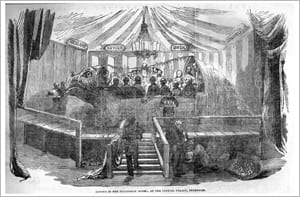Disneyland in south London
By Ben Stevens H P Stevens, on 18 June 2013
As a lecturer, you know you’re off to a great start when your chosen lecture topic is dinosaurs.
Ever since fossils were first discovered in the 19th century, the public has been fascinated with these prehistoric creatures.
It was this public fascination that gave rise to the wonderful dinosaur sculptures that still stand in Crystal Palace Park and which Professor Joe Cain (UCL Science and Technology Studies) focused on in his hugely entertaining Lunch Hour Lecture at the Museum of London on 5 June.
To be honest, such was the energy with which he bounded onto stage and commenced his lecture, he could have been talking about his tax returns and the audience would still have been rapt.
In case there was anyone in the audience who had not yet warmed to him, though, he got all of us to shout out, “Hi, Joe’s wife!” – as she was watching the lecture live on the Lunch Hour Lecture YouTube channel.
The two palaces
Professor Cain began the lecture with some context – explaining that there were actually two Crystal Palaces. The first was a temporary structure designed by the renowned architect and garden designer Joseph Paxton and used for the Great Exhibition of 1851.
The other was the grand edifice that was installed in 200 acres of countryside near Sydenham in south London (now called, unsurprisingly, Crystal Palace) in 1854.
It was built using the original temporary structure – which had been purchased by the newly formed Crystal Palace Company – but enlarged to such an extent that, when it opened, it was 500m long and was, in Professor Cain’s words, “like Disneyland in south London”.
In keeping with this description, the palace tried to mimic the British Museum with Byzantine and Egyptian galleries, but actually used copies of artefacts rather than the originals.
Dog shows and fountains
In fact, the Crystal Palace Company was so desperate to get people to return to the palace time and again, it even resorted to events such as dog shows to attract them.
In a similar vein, the company hired Joseph Paxton to design the park that surrounded the palace. He installed gigantic fountains that were fed by two 60m-high water towers designed by Isambard Kingdom Brunel and, in a further extravagant flourish, insisted that there were 22,000 fountainheads in total.
Even so, it soon became apparent to the company that the park was too large for its purposes and needed to be filled with further attractions.
Dinomania
This where the famed dinosaur sculptures come in. Made from brick and concrete over steel frames, they were designed by Benjamin Waterhouse Hawkins, a celebrated scientific illustrator.
During the 1850s, a series of fossils found in Lyme Regis and Whitby and displayed in the British Museum provoked huge public interest in these ‘terrible lizards’ – Dickens even referred to a megalosaurus in the opening of Bleak House – and Waterhouse Hawkins understood how the first sculptures of dinosaurs anywhere in the world would tap into this.
He was also a brilliant self-publicist and marked the launch of the dinosaurs by holding a banquet on New Year’s Eve 1853 inside one of the Iguanodon moulds – as recorded in the London Illustrated News (pictured).
To design the sculptures, he spoke to palaeontologists and other experts and showed them early sketches. He had grand aims for the dinosaurs – wanting them to instil a sense of awe, educate people about the prehistoric period and make them think philosophically.
In particular, he wanted visitors to think about time: the sculptures are ordered chronologically, starting with amphibians, then moving on to marine dinosaurs, land-based dinosaurs and finally on to mammals.
However, the sculptures are wildly inaccurate, as Waterhouse Hawkins only had very sparse fossil remains from which to work.
Guesswork at best
According to Professor Cain, the Dicynodon statue is the worst, as only its beak was known at the time, so Waterhouse Hawkins took a wild guess and made it resemble a tortoise.
Meanwhile, the two Iguanodon sculptures – which Professor Cain said reminded him of his sisters(!) – don’t even match because the two experts that Waterhouse Hawkins consulted couldn’t agree on what they looked like, so he followed the advice of both of them!
Nowadays, the dinosaurs are in urgent need of conservation from the effects of erosion and Professor Cain concluded his lecture by imploring us to join the campaign to safeguard these glorious Victorian follies.
Watch the lecture below
Links
Lobby Bromley Council
Crystal Palace Park Community Stakeholders Group
 Close
Close


